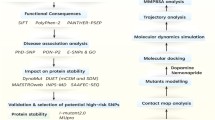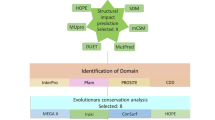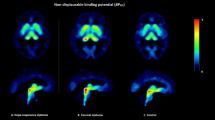Abstract
To investigate whether the dopaminergic system plays a role in the etiology of anorexia nervosa (AN) via the dopamine D2 receptor, we investigated association and transmission disequilibrium at seven single-nucleotide polymorphisms (SNPs) spanning about 75?kbp of the gene DRD2. We studied 191 probands with a DSM-IV diagnosis of AN, 457 parents and affected relatives with a DSM-IV eating disorder diagnosis, and 98 unrelated, female, normal weight controls. The −141 C/− insertion/deletion (−141 Indel), previously shown to affect DRD2 transcription efficiency, and multiple exon seven polymorphisms, one of which has previously been shown to affect DRD2 transcript stability, exhibited statistically significant association with diagnosis in haplotype transmission disequilibrium and in haplotype case?:?control analyses. Significant linkage disequilibrium between the −141 Indel and two exon seven SNPs (939Y and 957Y) was observed over a distance of >50?kbp in the AN probands but not in the controls. Genetically transmitted variation in D2 dopamine receptor expression mediated by functional polymorphisms affecting transcription and translation efficiency may play a role in vulnerability to AN.
Similar content being viewed by others
Log in or create a free account to read this content
Gain free access to this article, as well as selected content from this journal and more on nature.com
or
References
Arinami T, Gao M, Hamaguchi H, Toru M (1997). A functional polymorphism in the promoter region of the dopamine D2 receptor gene is associated with schizophrenia. Hum Mol Genet 6: 577–582.
Bacanu SA, Devlin B, Roeder K (2000). The power of genomic control. Am J Hum Genet 66: 1933–1944.
Bardo MT, Donohew RL, Harrington NG (1996). Psychobiology of novelty seeking and drug seeking behavior. Behav Brain Res 77: 23–43.
Bergen AW, van den Bree MB, Yeager M, Welch R, Ganjei JK, Haque K et al (2003a). Candidate genes for anorexia nervosa in the 1p33–36 linkage region: serotonin 1D and delta opioid receptor loci exhibit significant association to anorexia nervosa. Mol Psychiatry 8: 397–406.
Bergen AW, Yeager M, Welch R, Ganjei JK, Deep-Soboslay A, Haque K et al (2003b). Candidate gene analysis of the Price Foundation anorexia nervosa affected relative pair dataset. Curr Drug Target CNS Neurol Disord 2: 41–51.
Beumont PJ, Arthur B, Russell JD, Touyz SW (1994). Excessive physical activity in dieting disorder patients: proposals for a supervised exercise program. Int J Eat Disord 15: 21–36.
Blum K, Sheridan PJ, Wood RC, Braverman ER, Chen TJ, Comings DE (1995). Dopamine D2 receptor gene variants: association and linkage studies in impulsive–addictive–compulsive behaviour. Pharmacogenetics 5: 121–141.
Bulik CM, Tozzi F, Anderson C, Mazzeo S, Aggen S, Sullivan PF (2003). The relation between components of perfectionism and eating disorders. Am J Psychiatry 160: 366–368.
Cargill M, Altshuler D, Ireland J, Sklar P, Ardlie K, Patil N et al (1999). Characterization of single-nucleotide polymorphisms in coding regions of human genes. Nat Genet 22: 231–238.
Comings DE, Blum K (2000). Reward deficiency syndrome: genetic aspects of behavioral disorders. Prog Brain Res 126: 325–341.
Cravchik A, Goldman D (2000). Neurochemical individuality: genetic diversity among human dopamine and serotonin receptors and transporters. Arch Gen Psychiatry 57: 1105–1114.
Cravchik A, Sibley DR, Gejman PV (1996). Functional analysis of the human D2 dopamine receptor missense variants. J Biol Chem 271: 26013–26017.
Davis C, Woodside DB (2002). Sensitivity to the rewarding effects of food and exercise in the eating disorders. Comp Psychiatry 43: 189–194.
Devlin B, Bacanu SA, Klump KL, Bulik CM, Fichter MM, Halmi KA et al (2002). Linkage analysis of anorexia nervosa incorporating behavioral covariates. Hum Mol Genet 11: 689–696.
Duan J, Wainwright MS, Comeron JM, Saitou N, Sanders AR, Gelernter J et al (2003). Synonymous mutations in the human dopamine receptor D2 (DRD2) affect mRNA stability and synthesis of the receptor. Hum Mol Genet 12: 205–216.
Elston RC (2001). S.A.G.E. Statistical Analysis for Genetic Epidemiology. MetroHealth Campus, Case Western Reserve University: Cleveland.
Excoffier L, Slatkin M (1995). Maximum-likelihood estimation of molecular haplotype frequencies in a diploid population. Mol Biol Evol 12: 921–927.
Fichter MM, Herpertz S, Quadflieg N, Herpertz-Dahlmann B (1998). Structured interview for anorexic and bulimic disorders for DSM-IV and ICD-10: updated (third) revision. Int J Eat Disord 24: 227–249.
First MB, Gibbon M, Spitzer RL, Williams JB (1996). User's guide for the structured clinical interview for DSM IV axis I disorders-research version SCID-I, version 2.0. Biometrics Research, New York Stat Psychiatric Institute: New York.
Frank GK, Bailer UF, Henry SE, Drevets W, Meltzer CC, Price JC et al (in press). Increased Dopamine D2/D3 receptor binding after recovery from Anorexia Nervosa measured by positron emission tomography and [11C]raclopride. Biol Psychiatry.
Fujiwara Y, Yamaguchi K, Tanaka Y, Tomita H, Shiro Y, Kashihara K et al (1997). Polymorphism of dopamine receptors and transporter genes in neuropsychiatric diseases. Eur Neurol 38 (Suppl 1): 6–10.
Grandy DK, Litt M, Allen L, Bunzow JR, Marchionni M, Makam H et al (1989). The human dopamine D2 receptor gene is located on chromosome 11 at q22–q23 and identifies a TaqI RFLP. Am J Hum Genet 45: 778–785.
Grice DE, Halmi KA, Fichter MM, Strober M, Woodside DB, Treasure JT et al (2002). Evidence for a susceptibility gene for anorexia nervosa on chromosome 1. Am J Hum Genet 70: 787–792.
Halmi KA, Sunday SR, Strober M, Kaplan A, Woodside DB, Fichter M et al (2000). Perfectionism in anorexia nervosa: variation by clinical subtype, obsessionality, and pathological eating behavior. Am J Psychiatry 157: 1799–1805.
Itokawa M, Arinami T, Futamura N, Hamaguchi H, Toru M (1993). A structural polymorphism of human dopamine D2 receptor, D2(Ser311 → Cys). Biochem Biophys Res Commun 196: 1369–1375.
Kalivas PW (1993). Neurotransmitter regulation of dopamine neurons in the ventral tegmental area. Brain Res Brain Res Rev 18: 75–113.
Kaye WH, Bulik CM, Thornton L, Barbarich N, Masters K (2004). Comorbidity of anxiety disorders with anorexia and bulimia nervosa. Am J Psychiatry 161: 2215–2221.
Kaye WH, Frank GK, McConaha C (1999). Altered dopamine activity after recovery from restricting-type anorexia nervosa. Neuropsychopharmacology 21: 503–506.
Kaye WH, Lilenfeld LR, Berrettini WH, Strober M, Devlin B, Klump KL et al (2000). A search for susceptibility loci for anorexia nervosa: methods and sample description. Biol Psychiatry 47: 794–803.
Kebabian JW, Calne DB (1979). Multiple receptors for dopamine. Nature 277: 93–96.
Khan ZU, Mrzljak L, Gutierrez A, de la Calle A, Goldman-Rakic PS (1998). Prominence of the dopamine D2 short isoform in dopaminergic pathways. Proc Natl Acad Sci USA 95: 7731–7736.
Kidd KK, Morar B, Castiglione CM, Zhao H, Pakstis AJ, Speed WC et al (1998). A global survey of haplotype frequencies and linkage disequilibrium at the DRD2 locus. Hum Genet 103: 211–227.
Klump KL, Miller KB, Keel PK, McGue M, Iacono WG (2001). Genetic and environmental influences on anorexia nervosa syndromes in a population-based twin sample. Psychol Med 31: 737–740.
Kortegaard LS, Hoerder K, Joergensen J, Gillberg C, Kyvik KO (2001). A preliminary population-based twin study of self-reported eating disorder. Psychol Med 31: 361–365.
Kron L, Katz JL, Gorzynski G, Weiner H (1978). Hyperactivity in anorexia nervosa: a fundamental clinical feature. Comp Psychiatry 19: 433–440.
Lange C, Laird NM (2002a). On a general class of conditional tests for family-based association studies in genetics: the asymptotic distribution, the conditional power, and optimality considerations. Genet Epidemiol 23: 165–180.
Lange C, Laird NM (2002b). Power calculations for a general class of family-based association tests: dichotomous traits. Am J Hum Genet 71: 575–584.
Lilenfeld LR, Kaye WH, Greeno CG, Merikangas KR, Plotnicov K, Pollice C et al (1998). A controlled family study of anorexia nervosa and bulimia nervosa: psychiatric disorders in first-degree relatives and effects of proband comorbidity. Arch Gen Psychiatry 55: 603–610.
Morin PA, Saiz R, Monjazeb A (1999). High-throughput single nucleotide polymorphism genotyping by fluorescent 5′ exonuclease assay. Biotechniques 27: 538–540, 542, 544 passim.
Mukherjee J, Yang ZY, Brown T, Roemer J, Cooper M (1996). 18F-desmethoxyfallypride: a fluorine-18 labeled radiotracer with properties similar to carbon-11 raclopride for PET imaging studies of dopamine D2 receptors. Life Sci 59: 669–678.
O'Connell JR, Weeks DE (1998). PedCheck: a program for identification of genotype incompatibilities in linkage analysis. Am J Hum Genet 63: 259–266.
Rousset F, Raymond M (1995). Testing heterozygote excess and deficiency. Genetics 140: 1413–1419.
Salamone JD (1996). The behavioral neurochemistry of motivation: methodological and conceptual issues in studies of the dynamic activity of nucleus accumbens dopamine. J Neurosci Methods 64: 137–149.
Sarkar G, Kapelner S, Grandy DK, Marchionni M, Civelli O, Sobell J et al (1991). Direct sequencing of the dopamine D2 receptor (DRD2) in schizophrenics reveals three polymorphisms but no structural change in the receptor. Genomics 11: 8–14.
Schneider S, Roessli D, Excoffier L (2000). Arlequin Ver. 2.000: A Software for Population Genetic Analysis. Genetics and Biometry Laboratory, University of Geneva: Switzerland. http://anthro.unige.ch/alrequin.
Sohlberg S, Strober M (1994). Personality in Anorexia nervosa: an update and a theoretical integration. Acta Psychiatr Scand Suppl 378: 1–15.
Strober M, Freeman R, Lampert C, Diamond J, Kaye W (2000). Controlled family study of anorexia nervosa and bulimia nervosa: evidence of shared liability and transmission of partial syndromes. Am J Psychiatry 157: 393–401.
Sullivan PF (1995). Mortality in anorexia nervosa. Am J Psychiatry 152: 1073–1074.
Szczypka MS, Rainey MA, Kim DS, Alaynick WA, Marck BT, Matsumoto AM . et al (1999). Feeding behavior in dopamine-deficient mice. Proc Natl Acad Sci USA 96: 12138–12143.
Szczypka MS, Rainey MA, Palmiter RD (2000). Dopamine is required for hyperphagia in Lep(ob/ob) mice. Nat Genet 25: 102–104.
Usiello A, Baik JH, Rouge-Pont F, Picetti R, Dierich A, LeMeur M et al (2000). Distinct functions of the two isoforms of dopamine D2 receptors. Nature 408: 199–203.
Wade TD, Bulik CM, Neale M, Kendler KS (2000). Anorexia nervosa and major depression: shared genetic and environmental risk factors. Am J Psychiatry 157: 469–471.
Wang GJ, Volkow ND, Logan J, Pappas NR, Wong CT, Zhu W et al (2001). Brain dopamine and obesity. Lancet 357: 354–357.
Wise RA, Bozarth MA (1984). Brain reward circuitry: four circuit elements ‘wired’ in apparent series. Brain Res Bull 12: 203–208.
Acknowledgements
We are indebted to the participating families for their contribution of time and effort in support of this study. We wish to thank the Price Foundation for the support of the clinical collection of subjects and genotyping, and contribution to the support of data analysis. We wish to thank Neil Caporaso, MD, for comments on an earlier draft of the manuscript. Data analysis was also supported by a grant from the National Institute of Health (MH57881; BD) and a NARSAD Young Investigator Award (S-AB). Some of the results of this paper were obtained using the S.A.G.E. package of genetic epidemiology software, which is supported by a US Public Health Service Resource Grant (RR03655) from the National Center for Research Resources.
Author information
Authors and Affiliations
Corresponding author
Additional information
Supplementary Information accompanies the paper on the Neuropsychopharmacology website (http://www.nature.com/npp).
Supplementary information
Rights and permissions
About this article
Cite this article
Bergen, A., Yeager, M., Welch, R. et al. Association of Multiple DRD2 Polymorphisms with Anorexia Nervosa. Neuropsychopharmacol 30, 1703–1710 (2005). https://doi.org/10.1038/sj.npp.1300719
Received:
Revised:
Accepted:
Published:
Issue date:
DOI: https://doi.org/10.1038/sj.npp.1300719
Keywords
This article is cited by
-
A D2 to D1 shift in dopaminergic inputs to midbrain 5-HT neurons causes anorexia in mice
Nature Neuroscience (2022)
-
A review on association and correlation of genetic variants with eating disorders and obesity
Future Journal of Pharmaceutical Sciences (2021)
-
Activity-based anorexia animal model: a review of the main neurobiological findings
Journal of Eating Disorders (2021)
-
Exploration of Shared Genetic Architecture Between Subcortical Brain Volumes and Anorexia Nervosa
Molecular Neurobiology (2019)



